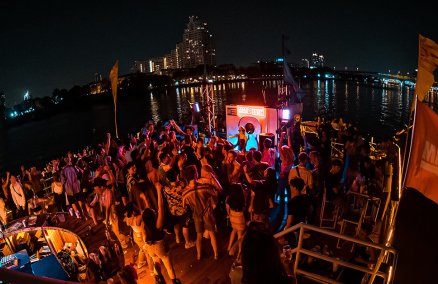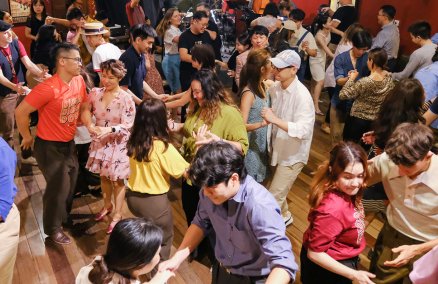It’s midday at Thonburi Remand Prison, a 26-rai facility that opened in 1994, and inmates are engaged in a rum Thai (traditional dance) performance under the huge canopy of an open auditorium. Watching the kratoey inmates dressed in traditional makeup, the show feels no different to one at a temple fair. We could almost forget the high walls separating this world from that outside.
The performance is part of a raft of new measures that aims to bring the prison in line with the United Nations’ Nelson Mandela Rules: “respect for prisoners’ inherent dignity; humane and limited disciplinary measures; treatment according to need and without discrimination; the further protection of society by reducing rates of re-offense; and valuing the safety of all prisoners, staff and visitors.”
Our hosts were Thitipun Manujantarat, the director of Court Custody and the man behind the prison’s adoption of the Mandela Rules, and Surased Roongin, director of the Custodial Division. Thitipun has much to be proud of: his progressive approach to prison management has brought the facility regional acclaim, with peers from other provinces visiting the facility to learn and adopt techniques.
Thitipun made sure we got a look at the equipment in his health clinic, the only one in Central Thailand, he told us, that offers treatment for those with mental disabilities. As we left the clinic, we passed a fenced area where prisoners sat in disconcertingly still rows, eyes trained on a television. “It helps them to focus,” Thitipun explained, noticing our gaze.
There was a deliberate stillness to the prison while we visited, the feel of a place holding its breath. When we entered a video room for new arrivals, we again found rows of very still prisoners, brown-clad, waiting for us.
Certain prison conventions are inescapable. The natural hierarchy of guard to prisoner, for example. In this case, the shrinking deference displayed by prisoners is perhaps exacerbated by the hierarchy in Thai society, part an internalized respect of station, and part greangjai.
We paused outside the dormitories, where a roster listed the names of inmates along with their crimes. “Seventy-two-percent of the inmates are here because of drug-related crimes,” Thitipun said. “Mostly, they were small-time suppliers, people who needed to make quick, easy money.”
Despite the talk of “treating them like family,” the prisoners were required to squat and turn their backs to us wherever we passed, a club-wielding guard standing over them. The officials insisted that this was a standard procedure for our safety.
Thitipun explained that part of the prison’s success comes from giving the prisoners some license over how they live within the prison, like choosing their own recreational activities.
“We are best known for our handicrafts and artwork,” he said. And so we arrived at what was truly inspiring and unexpected about this facility: an art gallery and classroom.
The single art teacher could be identified by his clothing. Otherwise, it was a portrait of craftsmen at work. Again, we encountered the hushed atmosphere, but here the stillness was genuine. The prisoners barely noticed us, so consumed were they in sculpting a khon mask, or carving the elephant trunk on a statue of Phra Pikanet (Ganesha), or finishing the sky in a watercolor painting. The art can be bartered for credits at the prison store, or purchased by outsiders. Gen. Prayuth Chan-ocha recently bought five wood carvings for B6,900 each.
“I studied art,” Thitipun said, and emphasized its meditative, soothing quality. “Only one person who has gone through this room has [after being released] recommitted his crime.”














